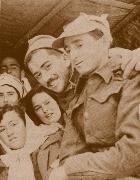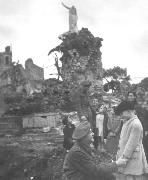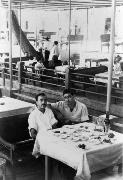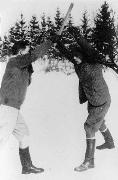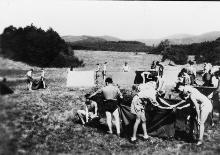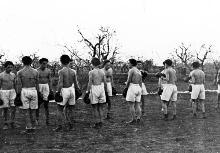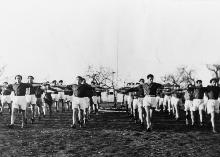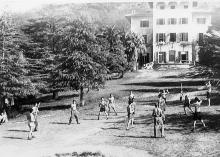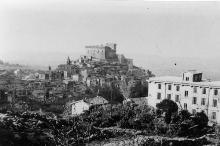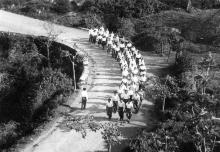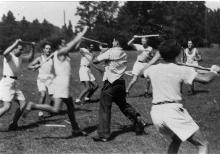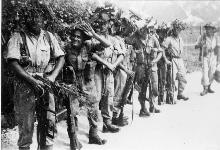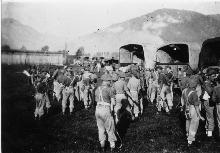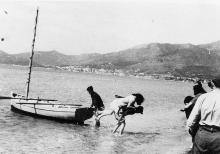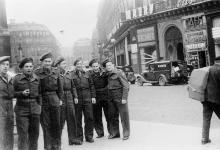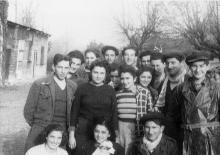| Hagana operations around the world |
Hagana operations in Europe Towards the end of World War II, Hagana and Hamossad for Aliya Bet (the organizations who led the Ha'apala - the illegal immigration to Palestine) operated mainly in Europe. Jewish soldiers serving in the British army, and especially those in the Jewish Brigade, assisted with immigration, acquisition of weapons, and smuggling the Holocaust survivors from refugee camps in Europe into Palestine. In October 1941, a Hagana branch was established in Europe, and Nachum Kramer-Shadmi was appointed its commander. Palmach assignments in Europe were defined by the national chief of Hagana Command, Moshe Sneh. The Jewish units in the British army, the Retribution Organization, established by soldiers and partisans, and the Jewish Underground Army (A.J) in France, were authorized to establish training camps and train the refuges to become combatants in the service of Hagana and later as soldiers in the IDF. The European branch of Hagana was responsible for fund raising, for the acquisition of weapons and other military equipment and their covert shipment to Israel. The European branch was also responsible for Retribution operations against Nazis. In addition to already operating training camps and an Officer Training School, 10 additional command Headquarters were established throughout Europe. During 1947, the Mossad for Aliya-B took care of 23,000 people; 10,000 recruits were trained and organized into combat units, as well as 2,000 officers. Following the U.N resolution of 29.11.1947, calling for the partition of Palestine and the establishment of a Jewish state in the land of Israel, 5,000 trained volunteers were transferred from Europe into Palestine, in collaboration with the Zionist movement and the Jewish institutions, and joined the Hagana fighting forces. The European branch managed to recruit and train altogether over 25,000 volunteers, mainly survivors of World War II. They joined the combat forces and contributed to Hagana and the IDF's victory on the battlefield. Hagana in Arab countries Hagana members, who originated from Arab countries, spoke fluent Arabic and were acquainted with the Arab culture and customs, assisted Jewish communities in Arab countries (Egypt, Iraq, Morocco, Tunisia, Syria) in establishing self-defense organizations and organized them for illegal immigration. Some were chosen to participate in officer training courses in Palestine; others were trained to operate wireless and other equipment, and succeeded to maintained communication with Hagana command in Israel. Members of the Hagana and Palmach organized Jews in Syria and smuggled them across the Syrian border into Palestine. During 1945 -1946 1,000 children and youth came this way from Syria. The Palmach's "Arab" unit included mainly immigrants from Arab countries. They operated as Mista'aravim (fighters disguised as Arabs), and were trained to operate in Arab countries disguised as Arabs, collecting intelligence and communicating by wireless to Hagana H.Q. during the War of Independence. The unit was named Hashachar (the dawn). Of its 40 members, 6 were killed in action. The unit was active until 1950. The Palmach's Arab unit also operated behind enemy lines during the war. Hagana in the U.S.A Hagana delegates were active in the US between World War II and Israel's War of Independence. They were responsible for the acquisition of weapons, shipping them to Palestine and for recruiting volunteers. 50% of the illegal immigrants reached Israel on ships purchased in the US, funded there by Jewish organizations. Many crewmembers were also recruited in the US. Since acquisition of weapons was illegal in the US, various Jewish institutions and agents purchased American army surplus. Some of the equipment was purchased in Mexico. Weapon and aircraft delivery was delayed until the establishment of the State of Israel due to the US embargo policy. Aircraft purchased in the US were: 3 B-17 Bombers; 5 fighter planes; cargo planes that carried weapons and aircraft from Europe; wireless & signal equipment, anti- aircraft guns, bazooka launchers, weapon manufacturing machinery, were brought to Israel disguised as agricultural equipment. In 1940, two pilot training courses were held in New York. The graduates became the first members of the new Israeli Air Force. Another course was held in California at the beginning of 1948, and its 13 graduates also joined the young Air Force. Gachal - Overseas Recruitment On the eve of the War of Independence and throughout the war, some 20,000 Gachal recruits from Europe and North Africa came to Israel. Training in the European refugee camps and detention camps in Cyprus was conducted by members of the Hagana and the Hamossad for Aliya Bet. Two main training facilities were established in south of France and south of Italy, and refugee camps were built near by. By the end of 1948, the 20,000 recruits composed about 1\5 of the total IDF recruits, and mainly joined the combat brigades. Russian and other East European experienced in combat veterans, made a most significant professional contribution to the IDF. Machal - Overseas Volunteers Jewish and non- Jewish volunteers came from all over the world to help Hagana and the IDF during the War of Independence. They numbered over 5,000. They held significant positions during the War. Their contribution was most evident in the Air Force (pilots, navigators, and ground crews), Navy, Armored and mechanized brigades, and in the medical corps. They comprised about 8% of the total military force after the declaration of independence. | |||||||||||

